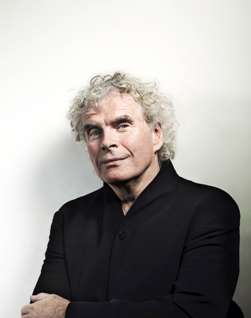|
Back
Triumph and Tragedy New York
Stern Auditorium, Carnegie Hall
10/10/2016 - & October 6, 2016 (Philadelphia)
Gustav Mahler: Symphony No. 6 in A minor
The Philadelphia Orchestra, Sir Simon Rattle (conductor)

S. Rattle (© Johann Sebastian Hanel)
“Mahler made the beautiful tragic and the tragic beautiful.”
Bruno Walter
The hypnotic quality of memory is explored in the sixth. As the most declarative of Mahler’s symphonies, the “Tragic” lives relentlessly in the present (“like being hit by a runaway train” a friend of mine once described it). On Monday, Simon Rattle led the Philadelphia Orchestra in a tightly wound and ultimately satisfying performance, rich in orchestral color if not always note perfect.
This heart-wrenching essay begins in medias res and its opening movement never lets up. Rattle led a rather deliberate beginning, a bit slower than most of his contemporaries. The first notable phenomenon was the improved orchestral balance of the ensemble, so much the superior to that of Eugene Ormandy, whose “great wall of strings” kept the winds and brass muffled at the old Academy of Music. Here the interesting positioning of his troops gave Rattle an edge: the consequence of having the celli in the front stage left gave extra oomph to the bottom of this sometimes rather insecure music and allowed this listener to hear a melody he had not recognized despite sixty years of familiarity.
Sir Simon takes the Andante moderato as the second movement. There is much controversy about this placement and Mahler is little help, publishing the Scherzo second in the original score but performing the Andante moderato second in his few live performances. Perhaps it is because I learned the originally published order as a little boy, but I always prefer the relentless positioning of movements to the more relaxed order now favored by most conductors. For me some of the intensity in these modern versions is forfeited and lost.
However, in the Andante moderato, which fulfills a role similar to that of the Adagietto of the Fifth Symphony (compare the sonority of the celeste in the Sixth to the harp of the Fifth), Mahler presents the heart-melting timbre of the horn against a gorgeous strophic string backdrop. Washes of emotion make up this writing for the strings and each wave is more painful than the last. The silence at the end of this passionate movement is one of the most delicious moments in all of Western music, although this night it was marred by the ensemble re-tuning before the onslaught of movements three and four. Only in the horn solo towards the end of the movement did there seem to be a stamp of originality, the otherwise adept player making the same “mistake” both times, leading to an interesting speculation that there was an anomaly in this particular published edition.
Mahler’s most concrete image of memory to date is the herdenglocken (cowbells) of the Sixth. In the first movement the bells are played offstage so that the herd, Mahler’s image of the pastoral nature of the nineteenth century, seems to be far away. In the Andante the bells are played onstage and the illusion is that the cows are passing right in front of the audience (Richard Strauss also uses this effect in his Alpine Symphony). As the herd passes, the civility of the nineteenth century journeys forever into oblivion. In the programmatic finale the herdenglocken are again offstage and even quieter than in the opening movement. The old way of life is now just a memory, forever a part of the void. This farewell to the nineteenth century will emerge again in the Seventh Symphony and the whole nature of saying goodbye and life becoming only a memory is the thematic material that forms the basis of that entire essay on the essence of memory that is the Symphony #9.
In this performance, however, the percussionist left the stage on cue, however his efforts at the cowbells went unheard. An audience member unfamiliar with the piece might have assumed that the man had several urgent biological needs that simply had to be addressed. Despite these niggling distractions, ultimately this was a fine performance and carries the frisson of thinking of what Sir Simon said a few years ago: that he would like to retire to Philadelphia and lead this excellent aggregation in his declining years.
Some years ago I heard two young musicians discussing which was the best recording of Mahler’s Seventh Symphony. I offered my opinion that it was the Rattle with the CBSO and leant my CD to one of the lads. When he returned it he stated “You were correct. With Rattle you hear everything!”
Fred Kirshnit
|